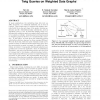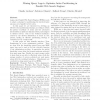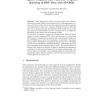265 search results - page 14 / 53 » How Many Query Superpositions Are Needed to Learn |
VLDB
2007
ACM
14 years 1 months ago
2007
ACM
In many applications, the underlying data (the web, an XML document, or a relational database) can be seen as a graph. These graphs may be enriched with weights, associated with t...
INFOSCALE
2007
ACM
13 years 9 months ago
2007
ACM
Large-scale Parallel Web Search Engines (WSEs) needs to adopt a strategy for partitioning the inverted index among a set of parallel server nodes. In this paper we are interested ...
ESWS
2009
Springer
13 years 5 months ago
2009
Springer
Many applications operate on time-sensitive data. Some of these data are only valid for certain intervals (e.g., job-assignments, versions of software code), others describe tempor...
EPIA
2005
Springer
14 years 1 months ago
2005
Springer
In this paper, we look at the Multi-Agent Meeting Scheduling problem where distributed agents negotiate meeting times on behalf of their users. While many negotiation approaches ha...
ICML
2008
IEEE
14 years 8 months ago
2008
IEEE
Sampling is a popular way of scaling up machine learning algorithms to large datasets. The question often is how many samples are needed. Adaptive stopping algorithms monitor the ...



